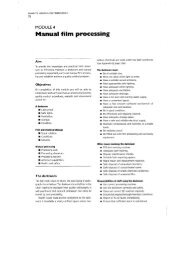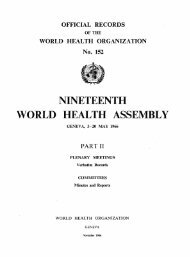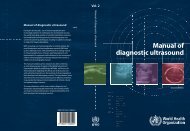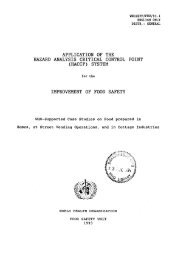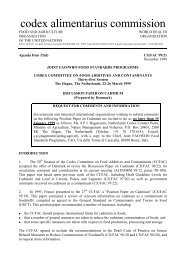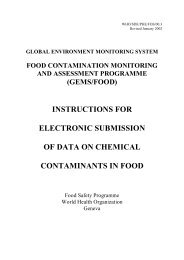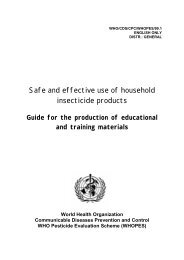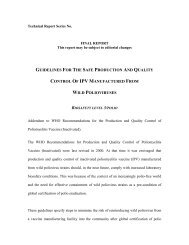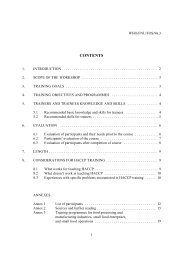WHO Drug Information Vol. 20, No. 4, 2006 - World Health ...
WHO Drug Information Vol. 20, No. 4, 2006 - World Health ...
WHO Drug Information Vol. 20, No. 4, 2006 - World Health ...
You also want an ePaper? Increase the reach of your titles
YUMPU automatically turns print PDFs into web optimized ePapers that Google loves.
Safety and Efficacy Issues<br />
2. Clarithromycin (Klacid®, Abbott)<br />
Contraindicated with concommitant use of<br />
ergotamine or dihydroergotamine. Under<br />
warnings, clarithromycin should only be<br />
used in pregnancy after risk/benefit<br />
assessment. Pseudomonas colitis is<br />
possible with clarithromycin/macrolide<br />
therapy. It is cautioned that cross-resistance<br />
between clarithromycin and other<br />
macrolide drugs is possible. New drug<br />
interactions include HMG-CoA reductase<br />
therapy, cisapride, pimozide, quinidine,<br />
disopyramide, colchicine and ritonavir.<br />
New ADRs include hypoglycaemia in<br />
patients on oral hypoglycaemic agents or<br />
insulin, leucopenia and thrombocytopenia,<br />
ventricular tachycardia, Torsades de<br />
Pointes, pancreatitis, convulsions and<br />
interstitial nephritis.<br />
3. Ciclosporin (Gengraf®, Abbott)<br />
New drug interactions documented with<br />
colchicine, quinopristin/dalfopristin,<br />
amiodarone, orlistat and St John’s Wort.<br />
Ciclosporin potentially enhances the toxic<br />
effects of colchicine especially in patients<br />
with renal dysfunction. Close monitoring<br />
is required in patients concurrently taking<br />
digoxin or colchicine. Myotoxicity has<br />
been reported with concomitant administration<br />
with HMG-CoA reductase inhibitors.<br />
4. Daunorubicin<br />
(Daunorubicin®, Pfizer)<br />
Contraindicated in pregnancy. New safety<br />
information added to the sections on<br />
cardiac toxicity and bone marrow depression.<br />
Significant hepatic or renal impairment<br />
can enhance the toxicity of recommended<br />
doses of daunorubicin. A rise in<br />
blood urea or uric acid can also occur<br />
with rapid destruction of leukaemia cells.<br />
Monitoring is thus required. <strong>Drug</strong> interaction<br />
includes vaccines and live virus.<br />
5. Fluticasone (Flixotide®, GSK)<br />
Very rare cases of increased blood<br />
glucose levels reported. Ritonavir (a<br />
254<br />
<strong>WHO</strong> <strong>Drug</strong> <strong>Information</strong> <strong>Vol</strong> <strong>20</strong>, <strong>No</strong>. 4, <strong>20</strong>06<br />
CYP3A4 inhibitor) can greatly increase<br />
fluticasone propionate plasma concentrations<br />
resulting in markedly reduced<br />
cortisol concentrations, Cushing<br />
syndrome and adrenal suppression.<br />
Caution should be exercised when<br />
CYP3A4 inhibitors, e.g. ketoconazole, are<br />
coadministered with fluticasone.<br />
6. Lidocaine, Prilocaine<br />
(Emla Cream®, AstraZeneca)<br />
Patients with G6PD deficieny or congenital<br />
or idiopathic methaemoglobinaemia<br />
are more susceptible to drug induced<br />
methaemoglobinaemia. If eye contact<br />
occurs, loss of protective reflexes may<br />
allow corneal irritation and potential<br />
abrasion. Patients treated with antiarrhythmic<br />
drugs class III (e.g. amiodarone)<br />
should be under close surveillance<br />
and ECG monitoring as cardiac effects<br />
may be additive. The results of intracutaneous<br />
injections of live vaccines (e.g.<br />
BCG) should be monitored as lidocaine<br />
and prilocaine have bacteriocidal and<br />
antiviral properties in concentrations<br />
above 0.5–2%. Caution should be exercised<br />
when using Emla® in pregnant<br />
women.<br />
7. Nimesulide (Nidol®,<br />
IDS Pharmaceuticals)<br />
Maximum dose is reduced to 100 mg<br />
twice daily. Some new contraindications<br />
include patients with a history of hepatotoxic<br />
reactions to nimesulide, cerebrovascular<br />
bleeding, severe coagulation<br />
disorders, severe heart failure, children<br />
under 12 years, third trimester of pregnancy<br />
and lactation. Avoid concomitant<br />
administration of hepatotoxic drugs and<br />
alcohol abuse. New drug interactions<br />
include valproic acid, lithium, methotrexate<br />
and ciclosporin.<br />
8. Propafenone (Rytmonorm®, Abbott)<br />
<strong>Drug</strong>s that inhibit CYP2D6, CYP1A2 and<br />
CYP3A4, might lead to increased levels<br />
of propafenone. Propafenone should be<br />
used with caution in nursing mothers.





